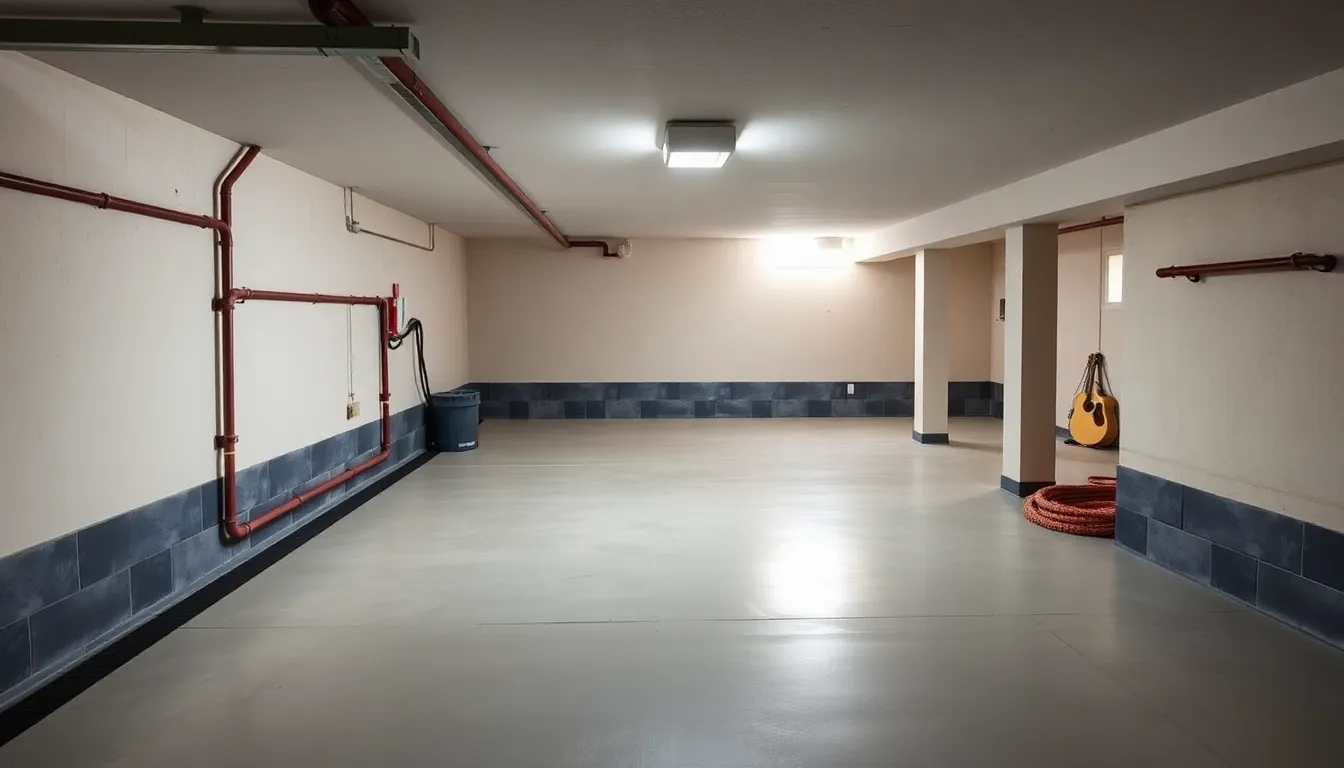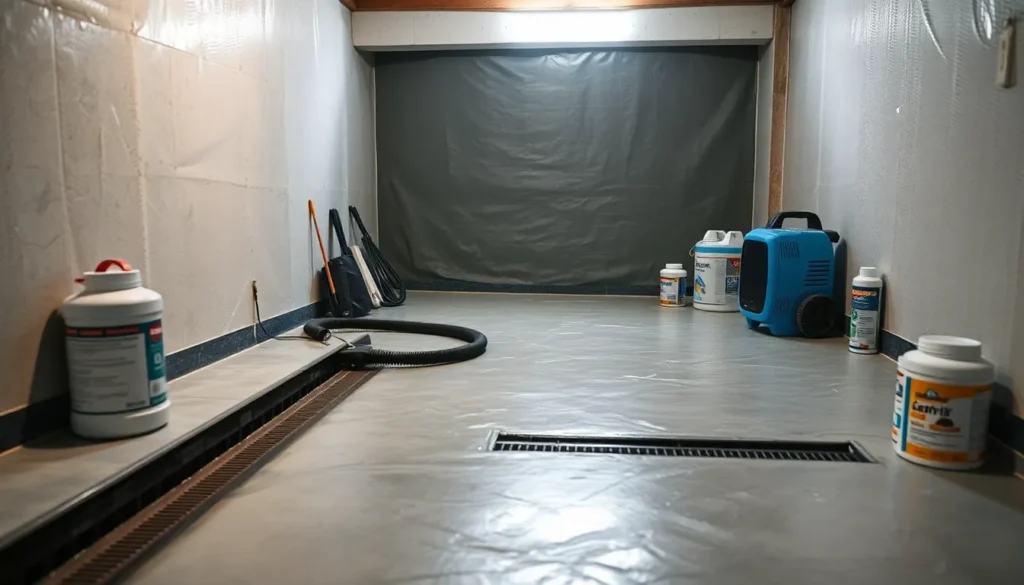Table of Contents
ToggleBasements can be great for storage or even a cozy hideaway, but when water starts to invade, they quickly turn into a swampy nightmare. Nobody wants to wade through their belongings like they’re on a treasure hunt in a flooded cave. That’s where basement waterproofing comes in, saving the day (and your stuff) from unwanted moisture and mold.
Imagine transforming your damp dungeon into a dry haven. With the right waterproofing solutions, homeowners can reclaim their basements and enjoy peace of mind. Not only does it protect your property, but it also keeps your home’s value intact. So, let’s dive into the world of basement waterproofing, where staying dry is the new cool, and mold is just a bad memory.
What Is Basement Waterproofing?
Basement waterproofing refers to methods and materials designed to keep water out of the basement. This process protects the space by preventing water intrusion from walls, floors, and foundation. Essential to maintaining a dry environment, waterproofing approaches include interior and exterior systems.
Interior waterproofing systems work to manage moisture levels inside the basement. Techniques like sealants and drainage systems redirect water, reducing the risk of mold growth. These methods target existing moisture issues and provide a dry living area.
Exterior waterproofing addresses water before it reaches the foundation. Professionals apply membranes or coatings to the outside of the walls. Effective exterior solutions create a barrier against groundwater, decreasing the likelihood of water seeping in.
Various signs indicate the need for waterproofing, such as damp walls, musty odors, and visible mold. Homeowners benefit from addressing these issues promptly. Preventing water damage maintains the basement’s structural integrity and enhances indoor air quality.
Choosing the right waterproofing method depends on specific basement conditions. Each approach offers unique advantages based on the severity of water issues. Consulting with a waterproofing expert helps identify the most effective solution for a homeowner’s needs.
Overall, basement waterproofing is vital for preserving a home’s value. It transforms potentially harmful spaces into functional areas, safeguarding possessions and providing peace of mind. Taking proactive steps ensures a dry, enjoyable basement environment.
Importance Of Basement Waterproofing

Basement waterproofing plays a crucial role in maintaining home safety and comfort. Homeowners benefit greatly from measures that prevent water intrusion and its associated damage.
Protecting Your Home
Water intrusion can lead to severe structural damage over time. Moisture encourages the growth of mold and mildew, creating health hazards for occupants. It also weakens foundational walls, resulting in costly repairs. Proper waterproofing techniques, including the installation of drainage systems and sealants, effectively protect against these issues. Utilizing interior waterproofing solutions helps manage moisture levels efficiently. Exterior methods further shield the foundation from groundwater and surface water. Immediate action upon noticing signs like damp walls or musty odors is essential for safeguarding the home.
Enhancing Property Value
Basements serve as valuable extensions of living space. A waterproof basement adds usable square footage, increasing the home’s overall appeal. Potential buyers are more likely to invest in a property that offers a dry and healthy environment. A well-maintained basement reduces the risk of structural issues, ultimately preserving property value. Reports show that effective waterproofing can offer significant returns on investment. Investing in waterproofing solutions creates peace of mind for homeowners and buyers alike. A dry basement ensures long-term value retention in an ever-competitive real estate market.
Methods Of Basement Waterproofing
Effective basement waterproofing involves both interior and exterior strategies designed to prevent water intrusion. Each method addresses the unique challenges posed by moisture.
Interior Waterproofing Solutions
Interior waterproofing solutions effectively manage moisture levels within the basement. Sealants serve as barriers, preventing water from penetrating walls and floors. Drainage systems, like sump pumps, collect and redirect water away from the space. Vapor barriers also play a crucial role, blocking moisture from the ground. Proper ventilation maintains air circulation, helping to reduce humidity and control smells. These interior methods not only protect belongings but also enhance indoor air quality.
Exterior Waterproofing Solutions
Exterior waterproofing solutions create barriers against water before it reaches the foundation. Grading around the home directs water away from the structure, reducing surface accumulation. Installing exterior drain systems, such as French drains, captures and channels groundwater away effectively. Waterproof coatings applied to exterior walls help seal out moisture. Landscape considerations, including the use of waterproof membranes, also contribute to protection. These methods work collectively to ensure the structural integrity of the home and prevent potential damage.
Choosing The Right Waterproofing System
Selecting the appropriate waterproofing system is essential for safeguarding a basement against water intrusion. Various factors determine the best fit based on individual needs and conditions.
Factors To Consider
Homeowners should evaluate the basement’s specific conditions. Identifying signs of moisture, like stains or musty odors, provides important insights. The type of soil surrounding the foundation can influence water resistance. Additionally, considering local climate variables helps in selecting durable solutions. Budget constraints often play a significant role, as some methods require more extensive investments than others. Finally, maintaining existing drains and gutters often proves critical to an effective waterproofing strategy.
Professional vs. DIY Options
Choosing between professional services and DIY options is often a priority for homeowners. Professional waterproofing offers comprehensive assessments and guarantees, ensuring the effectiveness of the solution implemented. On the other hand, DIY methods can save costs and provide hands-on experience, but they demand meticulous attention to detail. This choice hinges on the complexity of the issue at hand, as well as individual skill levels. Weighing the pros and cons assists homeowners in making informed decisions about which route to take.
Common Basement Waterproofing Problems
Basements often face unique waterproofing challenges. Recognizing issues early can significantly impact prevention tactics.
Signs Of Water Damage
Visible water stains often indicate moisture presence on walls or ceilings. Musty odors frequently signal mold growth linked to water intrusion. Peeling paint or wallpaper may suggest ongoing water issues that require immediate attention. Additionally, warped flooring can reveal hidden moisture levels that compromise structural integrity. Homeowners observing these signs should address them without delay to protect their basements and overall property value.
Preventative Measures
Regular maintenance of gutters and downspouts prevents excessive water accumulation around the foundation. Grading soil away from the foundation encourages proper drainage and minimizes water pooling. Installing sump pumps effectively removes water that enters the basement during heavy rains. Sealing cracks in walls and floors offers a barrier against moisture penetration. Employing vapor barriers is an additional measure to control moisture levels, particularly in humid climates or when dealing with groundwater. Implementing these strategies bolsters basement resilience and enhances the home’s overall safety.
Investing in basement waterproofing is essential for homeowners looking to protect their properties from water damage and mold growth. By implementing effective waterproofing solutions, they can transform their basements into functional and enjoyable spaces. It’s crucial to recognize the signs of moisture early and choose the right waterproofing system tailored to specific needs.
Regular maintenance and professional consultations can significantly enhance the effectiveness of waterproofing efforts. Ultimately, a dry and well-protected basement not only preserves property value but also contributes to a safer and healthier living environment. Homeowners can enjoy peace of mind knowing their investment is secure and their living space is free from the dangers of water intrusion.




